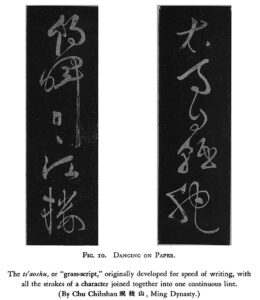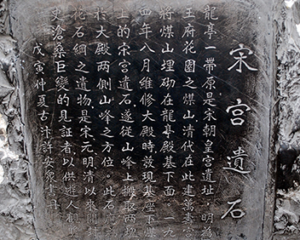Tag: Chinese history
Primary Sources: China and the Modern World: Missionary, Sinology, & Literary Publications
 China and the Modern World: Missionary, Sinology, and Literary Periodicals, 1817–1949 is a collection of seventeen English-language periodicals published in or about China during a period of over 130 years extending from 1817 until 1949, when the People’s Republic of China was founded. This corresponds to the periods of the late Qing Dynasty and the Republican Era (1911-1949), when China experienced radical and often traumatic transformations from an inward-looking imperial dynasty into a globally engaged republic with modern approaches to politics, literature, education, public morality, and intellectual life.
China and the Modern World: Missionary, Sinology, and Literary Periodicals, 1817–1949 is a collection of seventeen English-language periodicals published in or about China during a period of over 130 years extending from 1817 until 1949, when the People’s Republic of China was founded. This corresponds to the periods of the late Qing Dynasty and the Republican Era (1911-1949), when China experienced radical and often traumatic transformations from an inward-looking imperial dynasty into a globally engaged republic with modern approaches to politics, literature, education, public morality, and intellectual life.
Periodicals included in the collection:
- The Chinese Recorder (教務雜誌, 1867–1941) was produced by the Protestant missionary community in China that enjoyed a run of 72 years, longer than any other English-language publication in that country. The complete set of the journal, along with its predecessor, the Missionary Recorder, is available in this collection. The journal is regarded today as one of the most valuable sources for studying the missionary movement in China and its influence on Western relations with and perceptions of the Far East.
- West China Missionary News (華西教會新聞, 1899–1943) was established and published in Sichuan, China by the West China Missionary News Publication Committee. The journal aimed to enhance communication among missionaries based in western China and published many articles on the missionary activities in the region.
- The China Mission / Christian Year Book (中國基督教年鑑, 1910–1939) was published under an arrangement between the Christian Literature Society for China and the National Christian Council of China. It started in 1910 as The China Mission Year Book and changed its title to The China Christian Year Book in 1926. This digital version also includes The China Mission Hand-book (1896) and A Century of Protestant Missions in China (1807–1907).
- Educational Review: continuing the monthly bulletin of the Educational Association of China (教育季報, 1907–1938) was the official journal of the Educational Association of China which later changed its name to China Christian Educational Association. Founded in Shanghai in 1907, it was published first as a monthly during 1907–1912 and then as a quarterly during 1913–1938. The journal publishes minutes of the meetings of the Association and reports of affiliated local associations. There were also articles covering Christian colleges and universities founded across China.
- The Canton Miscellany (廣州雜誌, 1831) was a literary journal published in Guangzhou (Canton) between May and December 1831. Anonymously edited, it targets the well-educated English elite. The last two issues contain lengthy articles on the history of Macau, the first ever to be written in English.
- Chinese Miscellany (中國雜誌, 1845–1850) was founded by Walter Henry Medhurst (1796–1857), an English Congregationalist missionary to China. The journal consists of four volumes, introducing China’s silk and tea industry, geography, manufacturing, trade, and customs.
- The Chinese and Japanese Repository of Facts and Events in Science, History, and Art, Relating to Eastern Asia (中日叢報, 1863–1865) was edited by James Summers (1828–1891), a professor of Chinese language of the University of London. The journal documents China and Japan’s often violent reactions to the presence of foreigners from a Western perspective.
- Notes and Queries: on China and Japan (中日釋疑, 1867–1869) was one of the earliest sinology journals. Edited by Nicholas Belfield Dennys (1840–1900) and published in Hong Kong, it focuses on topics such as Chinese history and culture. Japan and Korea are also covered.
- The China Review: or Notes and Queries on the Far East (中國評論, 1872–1901) was arguably the first major Western sinology journal; many of the renowned sinologists of the nineteenth century contributed articles, including James Legge, Herbert A. Giles, Joseph Edkins, John Chalmers, Ernst Faber, Edward L. Oxenham, W. F. Mayers, Alexander Wylie, Edward Harper Parker, and Frederic Henry Balfour.
- The New China Review (新中國評論, 1919–1922) was established by British sinologist Samuel Couling in Shanghai in 1919, aiming to inherit the mantle of The China Review, which was discontinued in 1901. Contributors to its four volumes include such prominent sinologists as Herbert A. Giles and Edward H. Parker.
- The Indo-Chinese Gleaner (印中搜聞, 1817–1822) was a quarterly journal founded by Robert Morrison (1782–1834) and William Milne (1785–1822) in Malacca in 1817. This periodical covered missionary activities, reported on the social, political, religious, military, economic, and cultural affairs of China and other Asian countries, and introduced the literature, philosophy, and history of Asian countries, especially those of China and Southeast Asia.
- Bulletin of the Catholic University of Peking (輔仁英文學志, 1926–1934) was founded in September 1926 and published a total of nine volumes. Each volume contains articles on the university’s developments and achievements, as well as sections devoted to the study of Chinese culture. It ceased publication in November 1934 and gave way to a purely academic journal titled Monumenta Serica.
- The Yenching Journal of Social Studies (燕京社會學界, 1938–1950) was founded in June 1938 and published semi-annually. This journal, which ceased publication in 1950 after releasing the first part of Volume five, provides significant research materials on the history of social studies in China during the Republican period (1911–1949).
- The China Quarterly (英文中國季刊, 1935–1941), founded and run jointly by the China Institute of International Relations, the Pan-Pacific Association of China, and the Institute of Social and Economic Research, was an authoritative journal discussing topics on China’s internal and external affairs. The journal had a stellar editorial and contributor team, including such prominent scholars as Tsai Yuan-pei (蔡元培), Chungshu Kwei (桂中樞), Wu Lien-teh (伍連德), John Benjamin Powell, Hollington Tong (董顕光), and Lin Yu-tang (林語堂).
- T’ien Hsia Monthly (天下月刊, 1935–1941) was published under the auspices of the Sun Yat-sen Institute for the Advancement of Culture and Education. Editors included John C. H. Wu, Wen Yuan-ning, Lin Yu-tang, and others. This cultural and literary journal was dedicated to introducing and interpreting Chinese literature and art for the West and promoting understanding between East and West.
- The China Critic (中國評論週報, 1928–1946) was a weekly founded on 31 May 1928 by a group of Chinese intellectuals who had studied in the United States. Despite the editors’ avowed preference for “nonpolitical” discourse, The Critic’s editorials and articles frequently discussed the presence of imperialism in Shanghai, debated the abolition of extraterritoriality, and advocated equal access to public facilities in the concessions. The editors also participated in wider-ranging discussions about urban affairs.
- The China Year Book (中華年鑑, 1912–1939) was edited by British journalist and publisher H.G.W. Woodhead (1883–1959) with H.T.M. Bell to provide information on China for Westerners. It was published from 1912 to 1939, incorporating documents related to each year’s events in China. Woodhead was the editor of the Peking and Tientsin Times from 1914 to 1930 before moving to Shanghai to write for the Shanghai Evening Post and Mercury and later edit his own journal, Oriental Affairs.
Primary Sources: Books of Modern China & Picture Gallery of Chinese Modern Literature

The Library has recently acquired Books of Modern China (1840-1949), 中国近代图书全文数据库, a collection of more than 120,000 Chinese books published in Mainland China. Many of them are unique titles and are only available through this digital collection from the Shanghai Library.
The Picture Gallery of Chinese Modern Literature (1833-1949), 图述百年—中国近代文献图库 contains more than one million images that have been collected from books, periodicals, newspapers, and old photos held by the Shanghai Library.
These resources have been added to the History: Asia guide.
Primary Sources: Song Dai Mu Zhi Ming Database (Song Tomb Inscriptions Database)
 The Song Dai Mu Zhi Ming Database includes texts that have been collated from various sources including the Quan Song wen《全宋文》, unearthed epitaphs in recent years, and private rubbing collections. Sources are provided for each epitaph. Wherever available, high quality images of rubbings of original epitaphs have been added to the database and can be viewed side by side with the text. The database is full text searchable. The Song Tomb Inscriptions Database《宋代墓誌銘数据库》currently includes about 6,400 items, more items will be added in the future. [960-1270]
The Song Dai Mu Zhi Ming Database includes texts that have been collated from various sources including the Quan Song wen《全宋文》, unearthed epitaphs in recent years, and private rubbing collections. Sources are provided for each epitaph. Wherever available, high quality images of rubbings of original epitaphs have been added to the database and can be viewed side by side with the text. The database is full text searchable. The Song Tomb Inscriptions Database《宋代墓誌銘数据库》currently includes about 6,400 items, more items will be added in the future. [960-1270]
This resource allows for two simultaneous users. If you are having trouble accessing the content, please try again another time.
New Oxford Bibliographies Online
The Library has added three new Oxford Bibliographies to its online holdings: Military History, Education, and Chinese Studies.
You can access them using these direct URLS: